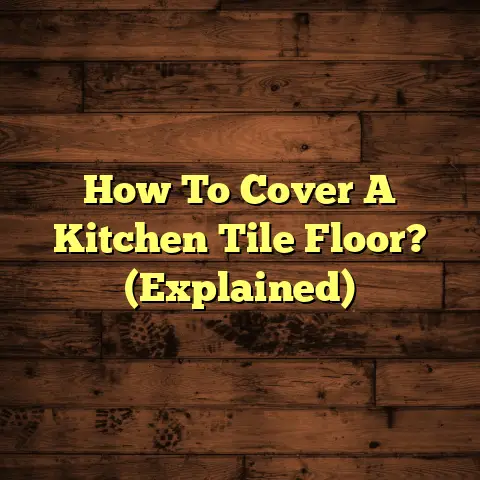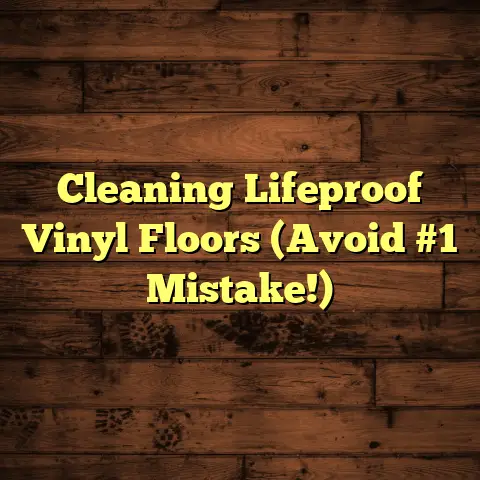Squeaky Floors? Quick Solutions (DIY in 6 Steps!)
I’ve been a flooring contractor for over 15 years, and I’ve seen it all – from water damage disasters to DIY attempts gone wrong. But one of the most common complaints I hear? Squeaky floors.
And guess what? It’s often something you can tackle yourself! Imagine not only saving money but also adding value to your home. According to a recent study by the National Association of Realtors, homes with well-maintained floors can see an increase in property value of up to 5%.
That’s a win-win!
So, let’s dive into the world of squeaky floors and how you can silence them in just six easy steps.
Section 1: Understanding Squeaky Floors
What exactly are squeaky floors? Simply put, it’s that annoying noise your floor makes when you walk on it. It’s usually caused by friction – two surfaces rubbing together.
But why are they rubbing together? Well, there are a few common culprits:
-
Loose Floorboards: This is the most frequent offender. Over time, nails or screws can loosen, allowing the floorboards to move and rub against the subfloor or each other.
-
Humidity Changes: Wood expands and contracts with changes in humidity. This can cause gaps to form and floorboards to shift, leading to squeaks.
-
Inadequate Installation: Sometimes, the problem stems from the very beginning. If the floor wasn’t installed correctly, it might not be properly secured, leading to movement and noise.
Now, which types of flooring are most prone to squeaking? Here’s a quick rundown:
-
Hardwood: Solid hardwood is beautiful, but it’s also susceptible to humidity changes. Those squeaks can really amplify through the planks.
-
Laminate: While more resistant to moisture than hardwood, laminate can still squeak if it’s not properly installed or if the subfloor isn’t level.
-
Engineered Wood: This is a bit more stable than solid hardwood, but the same principles apply. Loose installation or humidity can still cause issues.
I remember one client, Mrs. Davison, who was mortified because her dining room floor squeaked every time she had guests over. She was so embarrassed! It disrupted her dinner parties and made her feel self-conscious about her home.
That’s the thing about squeaky floors – they’re not just annoying; they can really impact your daily life and even your social interactions.
Section 2: Step-by-Step DIY Solutions
Alright, let’s get down to business! Here are six actionable steps you can take to fix those squeaky floors:
Step 1: Identify the Source of the Squeak
This is crucial! You can’t fix a squeak if you don’t know where it’s coming from.
Tips for pinpointing the squeak:
-
The Buddy System: Have a friend or family member walk slowly across the floor while you listen carefully. Pay attention to the exact location of the noise.
-
Mark the Spot: Use painter’s tape to mark the squeaky areas. This will help you stay focused during the repair process.
-
Listen from Below: If you have access to the space below the floor (like a basement or crawl space), have someone walk above while you listen from below. This can help you identify the exact point of friction.
Step 2: Gather Necessary Tools and Materials
Before you start, make sure you have everything you need. Here’s a basic checklist:
-
Screws: Choose screws that are long enough to penetrate the subfloor but not so long that they go through the flooring. I usually recommend 1 1/4″ to 1 5/8″ screws for most hardwood floors. You can find these at any hardware store like Home Depot or Lowes.
-
Wood Glue: This will help secure loose boards and prevent future squeaks. Titebond is a great brand.
-
Hammer: For gently tapping in loose nails (if applicable).
-
Screwdriver or Drill: To drive in the screws. A drill with a screw-driving attachment is ideal.
-
Talcum Powder, Graphite Powder, or WD-40: For lubricating the boards (we’ll get to that later).
-
Shims or Wood Filler: To fill gaps.
-
Safety Glasses: Protect your eyes from debris.
-
Gloves: To protect your hands.
Safety First! Always wear safety glasses and gloves when working on home improvement projects. And be careful when using power tools!
Step 3: Secure Loose Floorboards
This is often the first line of defense.
How to tighten loose boards:
-
Locate the loose board: This is where your marking from Step 1 comes in handy.
-
Pre-drill a pilot hole: This prevents the wood from splitting. Use a drill bit slightly smaller than the diameter of your screw.
-
Drive in the screw: Drive the screw in at a slight angle to help pull the board tight against the subfloor.
-
Countersink the screw: Use a countersinking drill bit to create a small recess for the screw head. This will allow you to cover it with wood filler later for a seamless look.
Diagram:
Floorboard
_________
/ \
/ \ <- Screw (angled)
/_____________\
Subfloor
Important Note: If you’re working with hardwood, be sure to match the screw head to the color of the wood. You can find color-matched screws at most hardware stores.
Step 4: Use Lubricants for Friction Reduction
Sometimes, the squeak isn’t caused by looseness but by simple friction. In these cases, a lubricant can work wonders.
How to apply lubricants:
-
Identify the friction point: This might be between two floorboards or between a floorboard and the subfloor.
-
Apply the lubricant:
- Talcum Powder or Graphite Powder: Sprinkle a small amount of powder into the gap and work it in with your finger or a brush.
- WD-40: Use the straw attachment to apply a small amount of WD-40 directly to the friction point. Be careful not to overdo it!
-
Test the area: Walk on the floor to see if the squeak is gone. If not, repeat the process.
Pro Tip: I prefer using graphite powder because it’s dry and doesn’t attract dust like WD-40 can.
Step 5: Fix Gaps with Shims or Wood Filler
Gaps between floorboards can also cause squeaks. Here’s how to fix them:
Using Shims:
-
Find the gap: Identify the gap that’s causing the squeak.
-
Insert the shim: Gently tap a thin wood shim into the gap using a hammer. Be careful not to force it in too far!
-
Trim the excess: Use a utility knife to trim the shim flush with the floor.
Using Wood Filler:
-
Clean the gap: Remove any debris from the gap.
-
Apply the wood filler: Use a putty knife to apply the wood filler to the gap.
-
Smooth the surface: Smooth the surface of the wood filler with the putty knife.
-
Let it dry: Allow the wood filler to dry completely according to the manufacturer’s instructions. This usually takes 24-48 hours.
-
Sand the surface: Once the wood filler is dry, sand it smooth with fine-grit sandpaper.
-
Stain (optional): If necessary, stain the wood filler to match the color of your floor.
Drying Times: Wood filler drying times can vary depending on the product and the humidity. Always check the manufacturer’s instructions.
Step 6: Reinforce with Additional Support
If the squeaking persists, you might need to reinforce the floor from below.
Adding Floor Joists or Blocking:
-
Access the underbelly: This requires access to the basement or crawl space.
-
Identify the squeaky area: Have someone walk on the floor above while you listen from below.
-
Add support:
- Floor Joists: If the existing joists are too far apart, you can add additional joists to provide more support.
- Blocking: Blocking is short pieces of wood that are installed between the joists to prevent them from twisting and squeaking.
Important Note: This step can be more complex and may require some carpentry skills. If you’re not comfortable working with tools or you’re unsure about the structure of your floor, it’s best to call a professional.
Section 3: Common Mistakes to Avoid
DIY projects can be rewarding, but it’s easy to make mistakes. Here are some common errors to avoid when fixing squeaky floors:
-
Over-tightening Screws: This can strip the screw holes and make the problem worse.
- Corrective Measure: Use the right size screw and don’t over-tighten it. If you strip a screw hole, you can use a wood screw anchor or a toothpick and wood glue to fill the hole before re-driving the screw.
-
Failing to Identify the Source: If you don’t pinpoint the exact location of the squeak, you’ll be wasting your time and effort.
- Corrective Measure: Take your time and use the tips in Step 1 to accurately identify the source of the squeak.
-
Using the Wrong Type of Lubricant: Some lubricants can damage your floor or attract dust.
- Corrective Measure: Stick to talcum powder, graphite powder, or WD-40. And always test the lubricant in an inconspicuous area first.
-
Ignoring Subfloor Issues: Sometimes, the problem isn’t with the floor itself but with the subfloor.
- Corrective Measure: Inspect the subfloor for damage or unevenness. If necessary, repair or replace the subfloor before attempting to fix the squeaky floor.
I had one client who tried to fix his squeaky floor by randomly screwing screws into the floorboards. He ended up making the problem worse and damaging his beautiful hardwood floor! That’s why it’s so important to take a systematic approach and avoid these common mistakes.
Section 4: Maintenance Tips for Squeak-Free Floors
Once you’ve fixed your squeaky floors, you’ll want to keep them that way! Here are some maintenance tips to help prevent future squeaks:
-
Regular Monitoring: Keep an eye (and ear) on your floors. If you notice any new squeaks, address them promptly.
-
Humidity Control: Maintain a consistent humidity level in your home. Use a humidifier or dehumidifier as needed. According to the EPA, ideal indoor humidity levels are between 30-50%.
-
Proper Cleaning: Avoid using excessive water when cleaning your floors. Water can seep into the cracks and cause the wood to expand and contract, leading to squeaks.
-
Furniture Pads: Use furniture pads under the legs of your furniture to prevent scratches and reduce friction.
-
Avoid Heavy Impact: Avoid dropping heavy objects on your floors. This can damage the floorboards and cause them to loosen.
Conclusion
Fixing squeaky floors might seem daunting, but it’s often a DIY project you can tackle yourself. By following these six steps, you can silence those annoying noises and enjoy the peace and quiet of your home.
And remember, there’s a real sense of accomplishment that comes from fixing something yourself. It’s not just about saving money; it’s about taking pride in your home and creating a more enjoyable living environment.
So, grab your tools, put on your safety glasses, and get ready to silence those squeaks! You’ve got this!
Call to Action
Now, I’d love to hear from you! Have you ever dealt with squeaky floors? What solutions have you found effective? Share your experiences in the comments below! And if you found this article helpful, please share it with others who might benefit from these DIY solutions. Let’s help everyone enjoy squeak-free floors!





